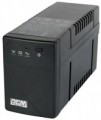Input voltage range
In this case, the input voltage range is implied, in which the UPS is able to supply a stable voltage to the load only due to its own regulators, without switching to the battery. For redundant UPSs (see "Type") this range is quite small, approximately 190 to 260 V; for interactive and especially inverter ones, it is much wider. Some UPS models allow you to manually set the input voltage range.
Max. current
The maximum current drawn by the UPS. In fact, the current reaches its maximum value only when the UPS is operating from the mains with maximum load power and a completely discharged battery. However, when calculating the load on the power grid, this parameter should be taken into account.
Output voltage accuracy
This parameter characterizes the degree of difference between the AC voltage at the output of the UPS and the perfect voltage, the graph of which has the shape of a regular sinusoid. The perfect voltage is so named because it is the most uniform and creates the least unnecessary load on the connected devices. Thus, the distortion of the output voltage is one of the most important parameters that determine the quality of the power received by the load. A distortion level of 0% means that the UPS produces a perfect sine wave, up to 5% — slight sine wave distortion, up to 18% — strong distortion, from 18% to 40% — a trapezoidal signal, more than 40% — a square wave.
Reserved C13/C14 connectors
Number of
C13/C14 connectors with power reserve provided in the UPS design.
Electrical appliances connected to connectors with a reserve are insured against a power failure in the network - in this case they switch to the battery. The C13/C14 connector itself is also known as a “computer socket”; it supplies the same 230 V as a regular household network, but is not compatible with plugs for traditional sockets, because uses three flat contacts. However, there are adapters between these standards.
At a minimum, the UPS is provided with
1,
2 or
3 C13/C14 connectors for one workstation. In more advanced, so to speak office ones, the number of C13/C14 connectors may be greater -
4 ports,
6 connectors,
8 and even more
Total battery capacity
The capacity of the battery installed in the UPS. For models with multiple batteries, this is both the total working capacity and the capacity of each individual battery: the batteries in such devices are usually connected in series, so that their total capacity corresponds to the capacity of each individual cell.
Theoretically, a higher battery capacity means the ability to power loads of a given capacity for longer. However, in fact, this parameter is more of a reference than practically significant. The fact is that the actual amount of energy stored by the battery depends not only on the capacity in amp-hours, but also on the voltage in volts; this voltage is often not specified in the characteristics, despite the fact that for accurate calculations it must be known. So when choosing, you should focus on more "close to life" characteristics — first of all, on the directly claimed operating time in different modes (see above).
Full charge time
The time it takes to fully charge the UPS battery. Note that in this case, this time is calculated according to special rules: not from 0 to 100% of the charge, but from a state in which it is impossible to maintain half the load, up to 90% of the charge. Of course, a full charge will take a little longer. However, this data is closer to practice than the “from 0 to 100%” calculation: the inability to work at half load makes the UPS practically useless, and this condition can be taken as zero, and 90% of the battery is already able to provide a good guarantee in case of a power failure.
Fuse
Fuses are used to protect the UPS from a critical increase in current strength: at the right time, they open the circuit, preventing unpleasant consequences. Today, these types of fuses are used.
— Melting. At a critical current strength, the conductive element in such a fuse melts and opens the circuit. The fusible protection is disposable, after operation such a fuse must be replaced.
— Automatic. Such a fuse has a sensor that monitors the current strength and opens the contacts at the right time. Its main difference from fusible is reusability: after operation, the circuit can be closed again with literally one press of the button on the fuse.
Surge protection
The maximum energy of an electrical impulse in the mains that the UPS is able to compensate. Short pulses with high energy from time to time can occur in almost all networks — for example, due to interference from powerful radiation sources or due to poor-quality operation of lightning protection on power lines; for unprotected devices, such fluctuations can be very harmful. The greater the amount of absorbed energy, the higher, respectively, the level
of impulse protectionprovided by the UPS.

